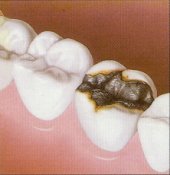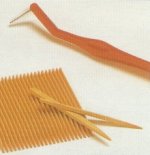
|
Why Do I Need a Crown?
|
|
| If you want your smile to be your crowning glory, you need healthy, attractive
teeth. When they are cracked, stained or damaged, however, your teeth detract from your dental health and your appearance, too. To
restore them, your dentist may recommend crowns. This section will help answer some of the common questions you may have about crowns.
|
What Are Crowns (Caps) And Why Are They Used?
A crown (cap) is a restoration that covers, or caps, a tooth to restore it to its normal shape and size. Its purpose is to strengthen or
improve the appearance of a tooth. A crown (cap) is placed for a number of reasons:
- to support a large filling when there isn't enough tooth remaining
- to attach a bridge
- to protect weak teeth from fracturing
- to restore fractured teeth
- to cover badly shaped or discolored teeth
- to cover a dental implant
|

|
|
|
| How Is A Crown (Cap) Placed?
|

Before
|

Crown Placed Over Prepared Tooth: The Tooth is Reduced on All Sides & Top
|

Crown in Place
|
Several steps are involved in placing a crown. Usually at least two visits are necessary. The dentist
will prepare the tooth by removing the outer portion of your tooth to accomodate the thickness of the crown. If the tooth has a filling, part of the material may be
left to serve as a foundation for the crown. An impression is made to provide an exact model of the prepared tooth. Your dentist or a dental laboratory technician,
following the written instructions of the dentist, will then make the crown from the model.
"Temporary" crowns (often made of acrylic resins) are placed while the permanent crown is made. If the shape or length of your teeth are changed for cosmetic
purposes, for example, temporary crowns will allow you to become accustomed to this change. They can also help you decide if you like what you see or if there are any
changes that you would like made before the permanent crowns are placed.
When the permanent crown is ready, the dentist puts it in place and makes necessary adjustments. To see how your crown will look, you can use a large mirror held at arms
length in various types of lighting. When you and your dentist are satisfied with your appearance, the crown will be cemented in place.
|
|
| How Do I Take Care Of My Crowns?
|
|
|
Brushing twice a day and cleaning between your teeth daily with floss or interdental cleaners (specially shaped
brushes and sticks or picks) is especially important when you have crowns. These measures remove a sticky film of bacteria called plaque. It is
especially important to remove plaque from the area where the gum meets the tooth (the sulcus). When plaque accumulates in the sulcus, it can cause
dental decay or gum disease. To prevent damaging or fracturing the crowns, avoid chewing hard foods, ice or other hard objects. It is also important
to visit your dentist regularly.
|
| What Will The Finished Crown Look Like?
|
One of your dentist's main goals is to create crowns that look like natural teeth. To achieve this, a
number of factors are considered such as the color, occlusion, or "bite", shape and length of both your natural teeth and of the artificial crown. Any
one of these factors alone can significantly affect your appearance.
If you have a certain look in mind for your crown, discuss it with your dentist at your initial visit. When the procedure is complete, your teeth may not only be
stronger, but they may be the most attractive feature of your face -- your crowning glory.
|










